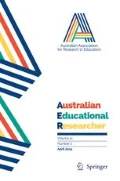Abstract
This paper examines ideas of cosmopolitanism, particularly social theorists’ interests in a cosmopolitan ‘disposition’, to consider how religiously diverse students experience campus life in a multi-faith Australian university. We draw on data from focus-group interviews conducted with students from Muslim, Christian, Spiritual, and Atheist student-groups to contribute empirical insights into theoretical debates about cosmopolitanism. We show how students understand religious relations in a university campus in multiple ways; moving back and forth between relations of religious openness and tension in different institutional scenarios. In light of these findings, we reflect on the possibilities of fostering ‘cosmopolitan religiosity’ in higher-education settings and demonstrate the limits of a liberal multicultural approach to religious diversity.
Similar content being viewed by others
References
Beck, U. (2010). A god of one’s own: Religion’s capacity for peace and potential for violence. Cambridge: Polity.
Beck, U., & Grande, E. (2010). Varieties of second modernity: The cosmopolitan turn in social and political theory and research. The British Journal of Sociology, 61(3), 409–443.
Delanty, G. (2009). The cosmopolitan imagination: The renewal of critical social theory. Cambridge: Cambridge University Press.
Dutton, E. (2008). Meeting jesus at university: Rites of passage and student evangelicals. Aldershot: Ashgate.
Gilliat-Ray. (2000). Religion in higher education: The politics of the multi-faith campus. Aldershot: Ashgate.
Hopkins, P. (2011). Towards critical geographies of the university campus: Understanding the contested experiences of muslim students. Transactions of the Institute of British Geographers, 36(1), 157–169.
Jakubowicz, A. (2006). Anglo-multiculturalism: Contradictions in the politics of cultural diversity as risk. International Journal of Media and Cultural Politics, 2(3), 249–266.
King, A., Doutre, J., & Macindoe, M. (2007). Alternatives to neo-liberal dictates in higher education: The fight against student poverty. The International Journal of Interdisciplinary Social Sciences, 2(2), 31–39.
Levey, G. (2009). Cultural diversity and its recognition in public universities: Fairness, utility and inclusion. In J. Zajda & H. Daun (Eds.), Global values education: Teaching democracy and peace, globalisation, comparative education and policy research (7) (pp. 143–153). Leiden: Springer.
Merry, M., & de Ruyter, D. (2009). Cosmopolitanism and the deeply religious. Journal of Beliefs and Values, 30(1), 49–60.
Merry, M., & de Ruyter, D. (2011). The relevance of cosmopolitanism for moral education. Journal of Moral Education, 40(1), 1–18.
Mizrachi, N. (2012). On the mismatch between multicultural education and its subjects in the field. British Journal of Sociology of Education, 33(2), 185–201.
Noble, G. (Ed.). (2009). Line in the sand: The Cronulla Riots, multiculturalism and national belonging. Sydney: Institute of Criminology Press.
Philipps, A. (2007). Multiculturalism without culture Princeton University Press. New Jersey: Princeton University Press.
Rizvi, F. (2009). Towards cosmopolitan learning. Discourse: Studies in the Cultural Politics of Education, 30(3), 253–268.
Siddiqui, A. (2007) Islam at Universities in England. Meeting the needs and investing in the future. Report to the Minister of Higher Education
Skrbis, Z., & Woodward, J. (2007). The ambivalence of ordinary cosmopolitanism: Investigating the limits of cosmopolitan openness. The Sociological Review, 55(4), 731–746.
Sommerville, C. (2006). The Decline of the Secular University. New York: Oxford University Press.
Turner, B. S. (2002). Cosmopolitan virtue. Globalisation and Patriotism Theory Culture & Society, 19, 45–63.
UWS (2011) About UWS University Website. Retrieved Aug 05, 2011, from http://www.uws.edu.au/about_uws/uws
Warhurst, J. (2004). Student unions, shop stewards and sausage rolls. Agenda, 12(2), 183–192.
Wise, A. (2005). Hope and belonging in a multicultural suburb. Journal of Intercultural Studies, 26(1), 171–186.
Wise, A., & Ali, J. (2008). Muslim-Australians & Local Government: Grassroots strategies to improve relations between Muslim and non-Muslim-Australians. Sydney: Centre for Social Inclusion.
Author information
Authors and Affiliations
Corresponding author
Rights and permissions
About this article
Cite this article
Sriprakash, A., Possamai, A. & Brackenreg, E. Cosmopolitan tensions: religious diversity in an Australian university. Aust. Educ. Res. 41, 227–242 (2014). https://doi.org/10.1007/s13384-013-0123-y
Received:
Accepted:
Published:
Issue Date:
DOI: https://doi.org/10.1007/s13384-013-0123-y




